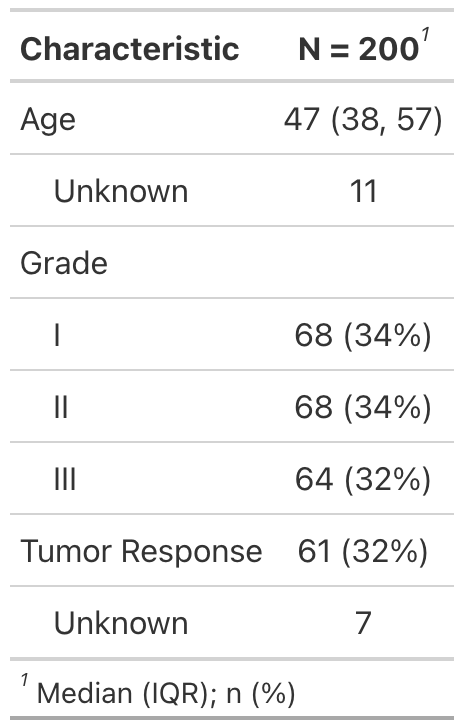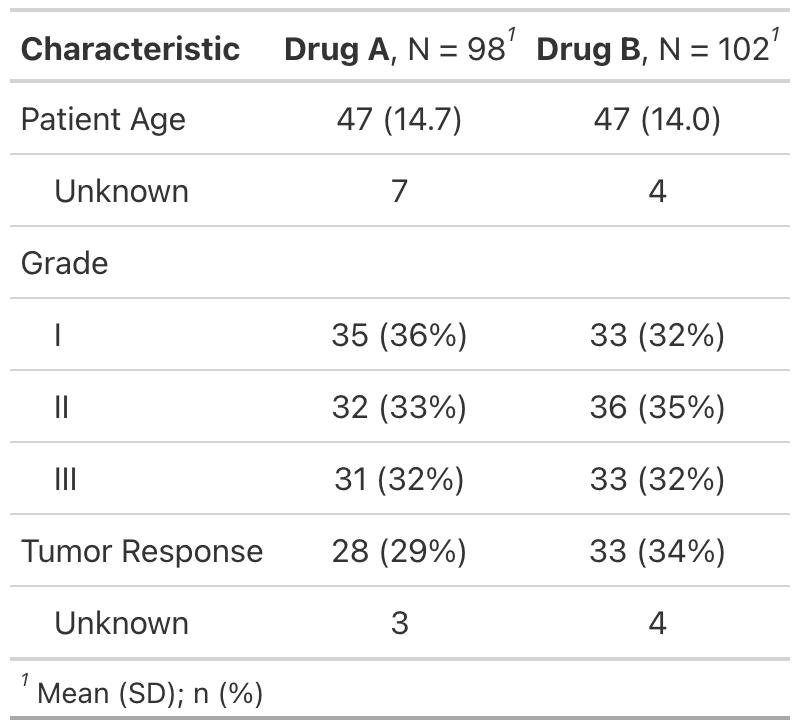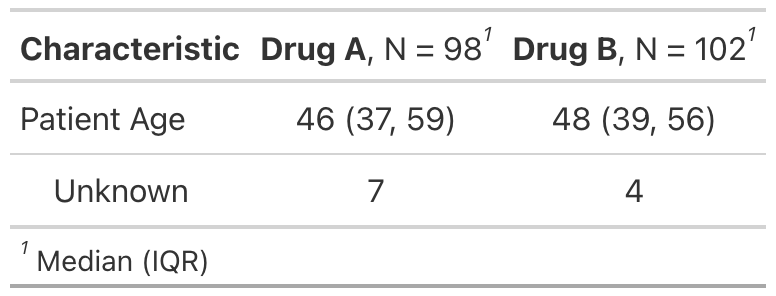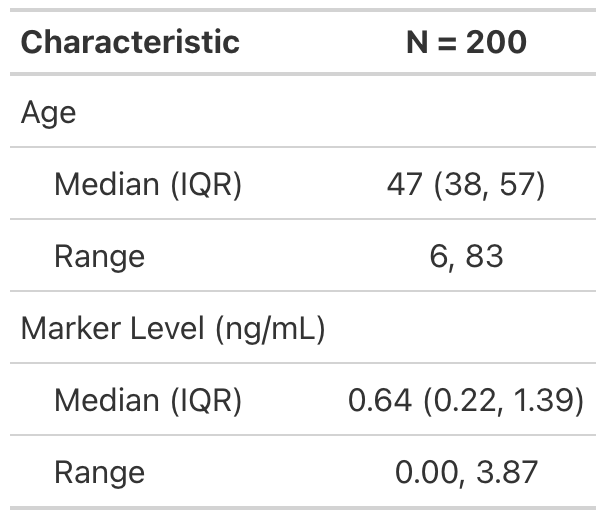Percentile of Continuous Variable by Groups R Dataframe
The tbl_summary function calculates descriptive statistics for continuous, categorical, and dichotomous variables. Review the tbl_summary vignette for detailed examples.
tbl_summary ( data, by = NULL, label = NULL, statistic = NULL, digits = NULL, type = NULL, value = NULL, missing = NULL, missing_text = NULL, sort = NULL, percent = NULL, include = everything ( ) ) Arguments
- data
-
A data frame
- by
-
A column name (quoted or unquoted) in
data. Summary statistics will be calculated separately for each level of thebyvariable (e.g.by = trt). IfNULL, summary statistics are calculated using all observations. To stratify a table by two or more variables, usetbl_strata() - label
-
List of formulas specifying variables labels, e.g.
list(age ~ "Age", stage ~ "Path T Stage"). If a variable's label is not specified here, the label attribute (attr(data$age, "label")) is used. If attribute label isNULL, the variable name will be used. - statistic
-
List of formulas specifying types of summary statistics to display for each variable. The default is
list(all_continuous() ~ "{median} ({p25}, {p75})", all_categorical() ~ "{n} ({p}%)"). See below for details. - digits
-
List of formulas specifying the number of decimal places to round summary statistics. If not specified,
tbl_summaryguesses an appropriate number of decimals to round statistics. When multiple statistics are displayed for a single variable, supply a vector rather than an integer. For example, if the statistic being calculated is"{mean} ({sd})"and you want the mean rounded to 1 decimal place, and the SD to 2 usedigits = list(age ~ c(1, 2)). User may also pass a styling function:digits = age ~ style_sigfig - type
-
List of formulas specifying variable types. Accepted values are
c("continuous", "continuous2", "categorical", "dichotomous"), e.g.type = list(age ~ "continuous", female ~ "dichotomous"). If type not specified for a variable, the function will default to an appropriate summary type. See below for details. - value
-
List of formulas specifying the value to display for dichotomous variables. gtsummary selectors, e.g.
all_dichotomous(), cannot be used with this argument. See below for details. - missing
-
Indicates whether to include counts of
NAvalues in the table. Allowed values are"no"(never display NA values),"ifany"(only display if any NA values), and"always"(includes NA count row for all variables). Default is"ifany". - missing_text
-
String to display for count of missing observations. Default is
"Unknown". - sort
-
List of formulas specifying the type of sorting to perform for categorical data. Options are
frequencywhere results are sorted in descending order of frequency andalphanumeric, e.g.sort = list(everything() ~ "frequency") - percent
-
Indicates the type of percentage to return. Must be one of
"column","row", or"cell". Default is"column". - include
-
variables to include in the summary table. Default is
everything()
Value
A tbl_summary object
select helpers
Select helpers from the \tidyselect\ package and \gtsummary\ package are available to modify default behavior for groups of variables. For example, by default continuous variables are reported with the median and IQR. To change all continuous variables to mean and standard deviation use statistic = list(all_continuous() ~ "{mean} ({sd})").
All columns with class logical are displayed as dichotomous variables showing the proportion of events that are TRUE on a single row. To show both rows (i.e. a row for TRUE and a row for FALSE) use type = list(where(is.logical) ~ "categorical").
The select helpers are available for use in any argument that accepts a list of formulas (e.g. statistic, type, digits, value, sort, etc.)
Read more on the syntax used through the package.
type argument
The tbl_summary() function has four summary types:
-
"continuous"summaries are shown on a single row. Most numeric variables default to summary type continuous. -
"continuous2"summaries are shown on 2 or more rows -
"categorical"multi-line summaries of nominal data. Character variables, factor variables, and numeric variables with fewer than 10 unique levels default to type categorical. To change a numeric variable to continuous that defaulted to categorical, usetype = list(varname ~ "continuous") -
"dichotomous"categorical variables that are displayed on a single row, rather than one row per level of the variable. Variables coded asTRUE/FALSE,0/1, oryes/noare assumed to be dichotomous, and theTRUE,1, andyesrows are displayed. Otherwise, the value to display must be specified in thevalueargument, e.g.value = list(varname ~ "level to show")
statistic argument
The statistic argument specifies the statistics presented in the table. The input is a list of formulas that specify the statistics to report. For example, statistic = list(age ~ "{mean} ({sd})") would report the mean and standard deviation for age; statistic = list(all_continuous() ~ "{mean} ({sd})") would report the mean and standard deviation for all continuous variables. A statistic name that appears between curly brackets will be replaced with the numeric statistic (see glue::glue).
For categorical variables the following statistics are available to display.
-
{n}frequency -
{N}denominator, or cohort size -
{p}formatted percentage
For continuous variables the following statistics are available to display.
-
{median}median -
{mean}mean -
{sd}standard deviation -
{var}variance -
{min}minimum -
{max}maximum -
{sum}sum -
{p##}any integer percentile, where##is an integer from 0 to 100 -
{foo}any function of the formfoo(x)is accepted wherexis a numeric vector
When the summary type is "continuous2", pass a vector of statistics. Each element of the vector will result in a separate row in the summary table.
For both categorical and continuous variables, statistics on the number of missing and non-missing observations and their proportions are available to display.
-
{N_obs}total number of observations -
{N_miss}number of missing observations -
{N_nonmiss}number of non-missing observations -
{p_miss}percentage of observations missing -
{p_nonmiss}percentage of observations not missing
Note that for categorical variables, {N_obs}, {N_miss} and {N_nonmiss} refer to the total number, number missing and number non missing observations in the denominator, not at each level of the categorical variable.
Example Output
Example 1

Example 2

Example 3

Example 4

See also
See tbl_summary vignette for detailed tutorial
See table gallery for additional examples
Review list, formula, and selector syntax used throughout gtsummary
Other tbl_summary tools: add_ci(), add_n.tbl_summary(), add_overall(), add_p.tbl_summary(), add_q(), add_stat_label(), bold_italicize_labels_levels, inline_text.tbl_summary(), inline_text.tbl_survfit(), modify, separate_p_footnotes(), tbl_custom_summary(), tbl_merge(), tbl_split(), tbl_stack(), tbl_strata()
Examples
# \donttest{ # Example 1 ---------------------------------- tbl_summary_ex1 <- trial %>% select ( age, grade, response ) %>% tbl_summary ( ) # Example 2 ---------------------------------- tbl_summary_ex2 <- trial %>% select ( age, grade, response, trt ) %>% tbl_summary ( by = trt, label = list ( age ~ "Patient Age" ), statistic = list ( all_continuous ( ) ~ "{mean} ({sd})" ), digits = list ( age ~ c ( 0, 1 ) ) ) # Example 3 ---------------------------------- # for convenience, you can also pass named lists to any arguments # that accept formulas (e.g label, digits, etc.) tbl_summary_ex3 <- trial %>% select ( age, trt ) %>% tbl_summary ( by = trt, label = list (age = "Patient Age" ) ) # Example 4 ---------------------------------- # multi-line summaries of continuous data with type 'continuous2' tbl_summary_ex4 <- trial %>% select ( age, marker ) %>% tbl_summary ( type = all_continuous ( ) ~ "continuous2", statistic = all_continuous ( ) ~ c ( "{median} ({p25}, {p75})", "{min}, {max}" ), missing = "no" ) # } Source: https://www.danieldsjoberg.com/gtsummary/reference/tbl_summary.html
0 Response to "Percentile of Continuous Variable by Groups R Dataframe"
Postar um comentário